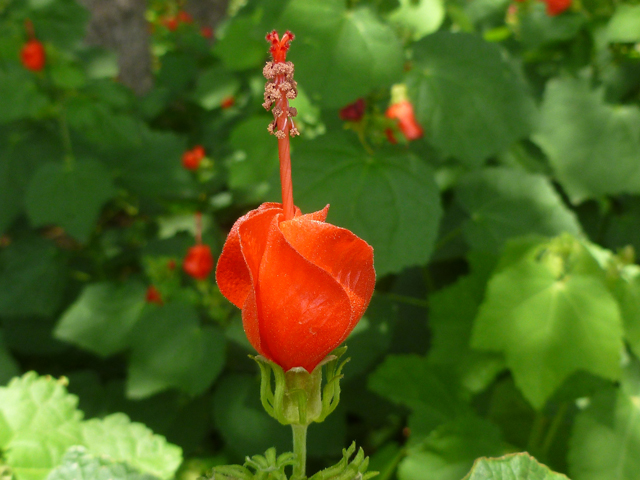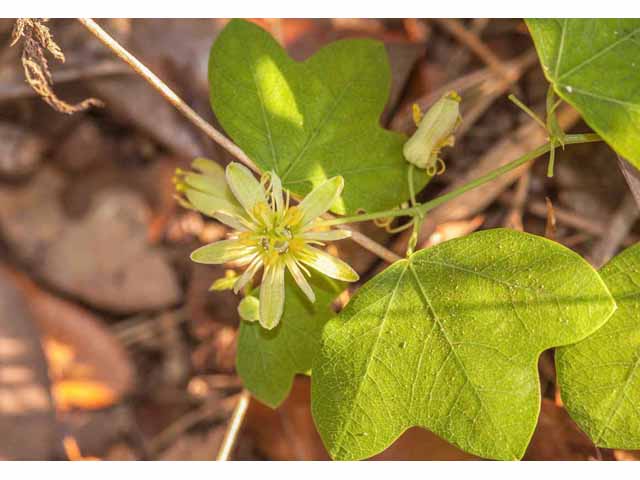This 20.2 acre pocket of wilderness is the 2nd largest track of native forest inside the 610 loop and more than 2 acres of wetland areas have been documented within the property. The nature preserve is a mixture of open grass greenbelt and forested interior.
At least 38 species of native trees have been surveyed in the nature preserve, which attract many migratory animals throughout the year. Water Oak, Loblolly Pine, Willow Oak, Live Oak, Sweet Gum and Hackberry are just some of the native trees that can be found in the nature preserve.
The following list of non-native species has been found in the nature preserve: Chinese Tallow, Chinaberry, Mimosa, Glossy Privet, Tree of Heaven, Heavenly Bamboo, Pink Lantana, Japanese Honeysuckle and Jerusalem Cherry. Friends of The Lorraine Cherry Nature Preserve work on an ongoing basis to identify and remove non-natives from the property.
BELOW ARE JUST SOME OF THE PLANTS THAT CAN BE SEEN AT TLCNP. CLICK ON EACH TO LEARN MORE.
American beautyberry
American beautyberry is a fast growing native perennial shrub. It can grow five to eight feet tall and almost as wide with drooping branches. The elliptical shaped leaves have an opposite arrangement with saw toothed edges. The underside of the leaves may be covered with wooly hairs. In late spring to early summer, inconspicuous flowers of blue, violet, pink, or white are arranged in clusters on the stems between the leaves. In August or September, clusters of small bright magenta colored berries or drupes encircle the woody stems. Each small berry in the cluster contains two to four seeds about 1/16 in. long.
Interesting fact: In the early 20th century, farmers would crush the leaves and place them under the harnesses of horses and mules to repel mosquitoes. The farmers rubbed the crushed leaves on themselves to repel mosquitoes and biting bugs. Studies conducted by the Agricultural Research Service have shown two compounds – callicarpenal and intermedeol - are responsible for the repellant.
American Beautyberry
Lantana
Lantana is a spreading shrub that thrives in the full summer sun and heat, requiring little water once established. It can grow to 6 feet tall. It is part of the verbena family of plants. More than 24 species of lantana grow in Texas. Thus Lantana can be seen in many colors: calico (yellow and red) pink, red and yellow. Most have ovate shaped leaves with pointy tip.
It takes the blistering heat of summer to bring it into its own, covering the entire plant in bicolor mixtures of yellow, red, pink, white, and orange flowers. Bees use the nectar of this plant in honey production. Lantana, is an excellent food-source for many butterflies.
Lantana blooms from April through October, and become most spectacular in the worst heat of the summer. The berries of all lantanas are reported to be poisonous
Checked skipper butterfly on Lantana.
Photo by Robert Delgado. Lantana at TLCNP.
Milkweed
Milkweeds are host plants for caterpillars of the Monarch butterfly. They are perennial plants, which mean an individual plant lives for more than one year, growing each spring from rootstock and seeds rather than seeds alone. Milkweeds are toxic to vertebrate herbivores if ingested due to the toxins contained in the leaves and stems. When Monarch larvae ingest Milkweed, they also ingest the plants' toxins. They store these compounds in their tissues, making the larvae and adults toxic to many potential predators. Vertebrate predators may avoid Monarchs because they learn that the larvae and adults taste bad and/or make them vomit.
There is considerable variation in the amount of toxins in different species of plants. Some northern species of Milkweed contain almost no toxins while others seem to contain so much of the toxins that they are lethal even to Monarch caterpillars. Milkweeds rely on butterflies, moths, bees, ants and wasps for pollination when they bloom May through September.
Monarch on Milkweed
Photo by Robert Delgado. Milkweed.
Photo by Robert Delgado. Milkweed.
Partridge Pea
Partridge pea is an annual legume plant that reaches a height of 1 to 3 feet. The narrow yellow-green leaves of this slender-stemmed plant consist of 10 to 15 pairs of small leaflets that fold together when touched. The showy flowers that normally bloom July through Septmeber attract both bees and butterflies. These flowers are about 1 inch across, grow 2 to 4 together in clusters on the stem. Songbirds will often be seen eating the seed pods of this native plant.
Partridge Pea also provides pollen for a number of other insects and birds relish the seed pods that follow the flowers. It is also a nectar source for bees, butterflies and ants. The Common Sulfur, Cloudless Giant Sulphur, Orange Sulphur and Sleepy Orange butterflies lays its eggs on the leaves, and the larvae use the leaves as a food source.
Partridge Pea
Saw Palmetto
This plant can often be found in the Southeastern United States. Palmettos are usually on the ground floor under the canopy of trees. This means that they do not receive a lot of sunlight. These plants adapt to their habitat by creating as much surface area as possible for the light to strike their leaves. As you can see from the pictures, there can be many leaves on one plant and these leaves can grow pretty long and thick. Their thick leaves help the plant to conserve water, use it efficiently and help it survive in times of low water conditions.
Photo by Robert Delgado. Saw Palmetto at TLCNP.
The Palmetto has been used for various medical and nutritional properties for a long time! The Mayans used saw palmetto as a tonic. The Seminole Indians used the berries as an antiseptic.
Turk’s cap
This spreading shrub, often as broad as it is high, grows 2 to 3 feet and sometimes reaching 9 feet in height. Bright-red, pendant, hibiscus-like flowers never fully open, their petals overlapping to form a loose tube with the staminal column protruding, said to resemble a Turkish turban, hence its most common name, Turks cap. The leaves are light to medium green color and the flowers are 2 to 3 inches in size.
Red flowers usually are produced in profusion during hot weather at the end of summer and early fall. It is a nectar plant for hummingbirds, butterflies, moths and insects.
Turk’s cap.
Winecup
This plant stems sprawl along the ground up to 3 feet wide, forming a thick mat up to 1 foot tall. Rounded, hairy leaves are deeply lobed and cleft. The 1 1/2 to 2 1/2 in. wide flowers have a white spot at the base of their five, maroon petals. The flowers, which are borne on long stalks, close in the evening, open in the morning and remain closed after pollination.
The Winecup, which blooms March through June, attracts both bees and butterflies. In addition, the Winecup serve as the larval host plant for the Gray Hairstreak butterfly.
Winecup.
Yellow Passionflower
This is a native vine that grows to up to 15 feet long, by either climbing or sprawling on the ground. This plant can have 1 to 3 flowers, arising from leaf axils, about 1 inch across, each on a stalk to 1 1/2 inches long. The yellowish-green flower(s) have numerous fringed floral parts. It blooms April through October.
The leaves of this plant alternate, are wide and three-lobed, to 4 1/2 inches long and 6 inches wide, on stalks up to 2½ inches long. The fruits of this plant are egg-shaped or nearly spherical berries containing seeds surrounded by pulpy material, green becoming dark purple at maturity, about 1/2 inch long. Like some other passion vines Yellow Passionflower spreads by root suckers.
This vine is not only a nectar plant, but also a larva host for the following butterflies: Julia, Mexican Fritillary, Gulf Fritillary, Zebra and Crimson-patch Longwing.
Yellow Passionflower.











